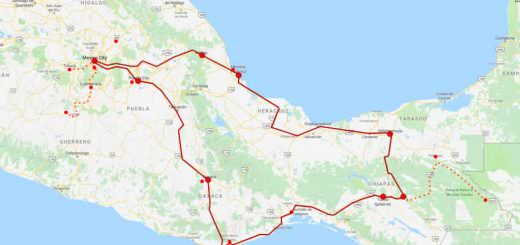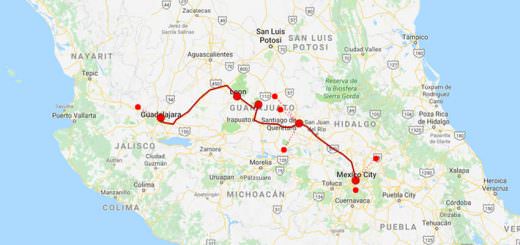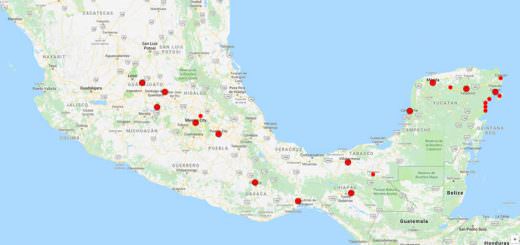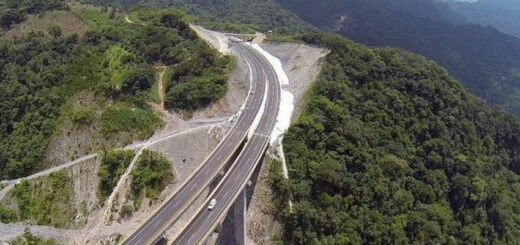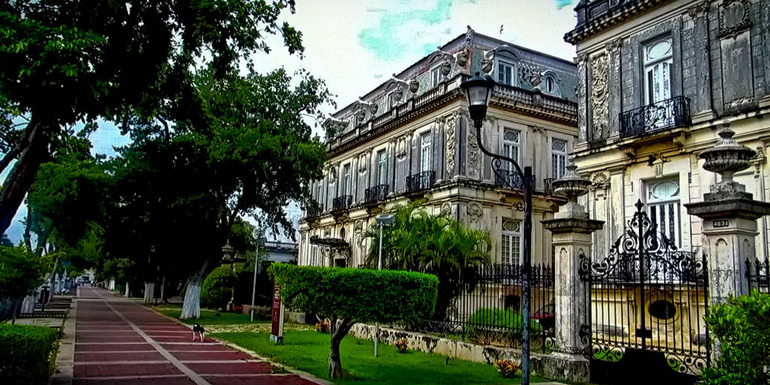
Merida
Mérida is the capital and largest city of the Mexican state of Yucatán as well as the largest city of the Yucatán Peninsula. It is located in the northwest part of the state, about 35 km from the Gulf of Mexico coast.
The city is also the municipal seat of the Municipality of Mérida. Mérida is a cultural center with museums, art galleries, restaurants, movie theatres, and shops. The city retains an abundance of beautiful colonial buildings.
At the same time, it is a modern city boasting a comprehensive range of shopping malls, auto dealerships, top-quality hotels, restaurants, and leisure facilities. The famous avenue Paseo de Montejo is lined with original sculptures.
The city, like much of the state, has heavy Mayan, Spanish, French, British, and to a lesser extent Dutch influences.
Mérida has served as the American Capital of Culture in the years 2000 and 2017.
Geo & Climate
Mérida is located in the northwest part of the state of Yucatán, which occupies the northern portion of the Yucatán Peninsula.
The city is also located in the Chicxulub Crater. It has a very flat topography and is only 9 m above sea level.
The land outside of Mérida is covered with smaller scrub trees and former henequen fields. Almost no surface water exists, but several cenotes (underground springs and rivers) are found across the state.
Climate
Merida features a tropical wet and dry climate. The city lies in the trade wind belt close to the Tropic of Cancer, with the prevailing wind from the east. Mérida’s climate is hot and its humidity is moderate to high, depending on the time of year.
The average annual high temperature is 33°C, ranging from 28°C in January to 36°C in May, but temperatures often rise above 38°C in the afternoon during this time.
Low temperatures range between 18°C in January to 23°C in May and June. It is most often a few degrees hotter in Mérida than in coastal areas due to its inland location and low elevation.
The rainy season runs from June through October, associated with the Mexican monsoon which draws warm, moist air landward. Easterly waves and tropical storms also affect the area during this season.
Origin of the Name
Mérida was named after the Spanish town of the same name.
It is the largest of the four cities in the world that share the name Mérida, the other three being in Spain, Venezuela, and the Philippines.
Mérida has been nicknamed “The White City” (La Ciudad Blanca), though the exact origin of this moniker is not clear.
Some explanations include the common color of its old buildings painted and decorated with “cal” (though anyone visiting modern Mérida can see that buildings are not all white nowadays) or the fact that the residents keep the city particularly clean.
History & Timeline
There were three Spanish conquistadors named “Francisco de Montejo”:
- Francisco de Montejo “el Adelantado” (“The Lieutenant”, the eldest)
- Francisco de Montejo y León “el Mozo” (“The Boy”, his son)
- Francisco de Montejo “el Sobrino” (“The Nephew”)
Mérida was founded in 1542 by Montejo y León (“el Mozo”) and named after the town of Mérida in Extremadura, Spain.
It was built on the site of the Maya city of T’hó, which was also called Ichkanzihóo or Ichcaanzihó (“City of Five Hills”) in reference to its pyramids. T’ho had been a center of Mayan culture and activity for centuries: because of this, some historians consider Mérida the oldest continually occupied city in the Americas.
Carved Maya stones from ancient T’ho were widely used to build the Spanish colonial buildings that are plentiful in downtown Mérida and are visible, for instance, in the walls of the main cathedral.
Much of Mérida’s architecture from the colonial period through the 18th century and 19th centuries is still standing in the historic center of the city. From colonial times through the mid-19th century, Mérida was a walled city intended to protect the Peninsular and Criollo residents from periodic revolts by the indigenous Maya.
Several of the old Spanish city gates survive, but modern Mérida has expanded well beyond the old city walls.
Late in the 19th century and the early 20th Century, the area surrounding Mérida prospered from the production of henequén. For a brief period, around the turn of the 20th century, Mérida was said to house more millionaires than any other city in the world.
The result of this concentration of wealth can still be seen today. Many large and elaborate homes still line the main avenue called Paseo de Montejo, though few are occupied today by individual families.
Many of these homes have been restored and now serve as office buildings for banks and insurance companies. Korean immigration to Mexico began in 1905 when more than a thousand people arrived in Yucatan from the city of Incheon.
These first Korean migrants settled around Merida as workers in henequen plantations.
Mérida has one of the largest centro histórico districts in the Americas (surpassed only by Mexico City and Havana, Cuba).
Colonial homes line the city streets to this day, in various states of disrepair and renovation; the historical center of Mérida is currently undergoing a minor renaissance as more and more people are moving into the old buildings and reviving their former glory.
In August 1993, Pope John Paul II visited the city on his third trip to Mexico. The city has been host to two bilateral United States – Mexico conferences, the first in 1999 (Bill Clinton – Ernesto Zedillo) and the second in 2007 (George W. Bush – Felipe Calderón).
In June 2007, Mérida moved its city museum to the renovated Post Office building next to the downtown market. The Museum of the City of Mérida houses important artifacts from the city’s history, as well as an art gallery.
Mérida hosted the VI Summit of Association of Caribbean States, in 2014.
Mérida is the cultural and financial capital of the Yucatán Peninsula, as well as the capital city of the state of Yucatán. In recent years, important science competitions and World events have been held in Mérida – FITA Archery World Cup Finals, the International Cosmic Ray Conference, a Physics Olympiad, etc.
Tourist Attractions & Sightseeing
Mérida has a “centro histórico” (“hisctoric center”) typical of colonial Spanish cities.
The street grid is based on odd-numbered streets running east/west and even-numbered streets running north/south, with Calles 60 and 61 bounding the “Plaza Grande” in the heart of the city.
The more affluent neighborhoods are located to the north and the most densely populated areas are to the south.
The “Centro Histórico” area is becoming increasingly popular with Americans and other expats who are rescuing and restoring the classic colonial structures.
Historic sites
- Monumento à la Patria (1956)
- Palacio de Gobierno (1892)
- Catedral de San Ildefonso (1598), first in the continental Americas
- Barrio y Capilla de Santa Lucía (1575)
- Barrio y Templo Parroquial del antiguo pueblo de Itzimná
- Barrio y Templo Parroquial de San Cristóbal (1796)
- Barrio y Templo Parroquial de San Sebastián (1706)
- Barrio y Templo Parroquial de Santa Ana (1733)
- Barrio y Templo Parroquial de Santa Lucía (1575)
- Barrio y Templo Parroquial de Santiago (1637)
- Capilla de Nuestra Señora de la Candelaria (1706)
- Capilla y parque de San Juan Bautista (1552)
- Casa de Montejo (1549)
- Antiguo convento de Nuestra Señora de la Consolación (Nuns)(1596)
- Iglesia del Jesús o de la Tercera Orden (Third Order) (1618)
- Templo de San Juan de Dios (1562)
Cultural Centers, Museums & Theaters
Mérida has served as the American Capital of Culture in the years 2000 and 2017.
Each year, the MACAY Museum in Mérida mounts a new sculpture installation, featuring works from Mexico and one other chosen country. Each exhibit remains for ten months of the year. In 2007, sculptures on Paseo de Montejo featured works by artists from Mexico and Japan.
For English speakers or would-be speakers, Mérida has the Mérida English Library, a lending library with an extensive collection of English books, videos, tapes, and children’s books. The library is also the site for expatriate meetings, children’s storytelling hours, and other cultural events.
Mérida is also home to the Yucatan Symphony Orchestra, which plays regular seasons at the Jose Peon Contreras Theatre on Calle 60 and features classical music, jazz, and opera.
Cultural centers
- Centro Cultural Andrés Quintana Roo, in Santa Ana, with galleries and artistic events
- Centro Cultural Olimpo. Next to the Municipal Palace in the Plaza Grande
- Casa de la Cultura del Mayab, the Casa de Artesanías (house of handcrafts) resides there. It’s in downtown Mérida
- Centro Estatal de Bellas Artes (CEBA). Across the El Centenario, offers classes and education in painting, music, theater, ballet, jazz, folklore, and Spanish dance, among others
- Centro Cultural del Niño Yucateco (CECUNY) in Mejorada, in a 16th-century building, with classes and workshops specifically designed for kids
- Centro Cultural Dante is a private center within one of the major bookstores in Mérida (Librería Dante)
Museums
- Gran Museo del Mundo Maya, Yucatán’s Mayan Museum, offers a view of Yucatán’s history and identity
- Museo de Antropología e Historia “Palacio Cantón”, Yucatán’s History and Archaeology Museum
- Museo de Arte Contemporáneo Ateneo de Yucatán (MACAY), in the heart of the city right next to the Cathedral. Permanent and rotating pictorial expositions
- Museo de la Canción Yucateca Asociación Civil in Mejorada, honors the trova yucateca authors, Ricardo Palmerín, Guty Cárdenas, Juan Acereto, Pastor Cervera y Luis Espinosa Alcalá
- Museo de la Ciudad de Mérida, in the old Correos (post office) building since 2007 offers information about the city from the prehispanic times’ Tho’ or Ichcaanzihó to current days
- Museo de Historia Natural, natural history museum
- Museo de Arte Popular, a popular art museum, offers a view of popular artistry and handcrafts among ethnic Mexican groups and cultures
- Museo Conmemorativo de la Inmigración Coreana a Yucatán
Major theaters with regular shows
- Teatro José Peón Contreras
- Teatro Daniel Ayala Pérez
- Teatro Mérida (Now Teatro Armando Manzanero)
- Teatro Colón
- Teatro Universitario Felipe Carrillo Puerto
- Teatro Héctor Herrera
Traditions, Holidays & Festivals
Mérida and the state of Yucatán have traditionally been isolated from the rest of the country by geography, creating a unique culture. The conquistadors found the Mayan culture to be incredibly resilient, and their attempts to eradicate Mayan tradition, religion, and culture had only moderate success.
The surviving remnants of the Mayan culture can be seen every day, in speech, dress, and in both written and oral histories. It is especially apparent in holidays like Hanal Pixan, a Mayan/Catholic Day of the Dead celebration.
It falls on November 1 and 2 (one day for adults, and one for children) and is commemorated by elaborate altars dedicated to dead relatives. It is a compromise between the two religions with crucifixes mingled with skull decorations and food sacrifices/offerings.
Suggested Tours & Excursions from Merida
Merida is a perfect city to stay there for a while exploring the surrounding areas in daily tours on your own or guided ones.
Suggested 1-day tours from Merida:
- Uxmal + Kabah
- Uxmal + Kabah + Sayil + Xlapak + Labna + Chacmultun (Puuc Route)
- Acanceh + Mayapan
- Ake + Izamal
- Mani
- Dzibilchatun
- Progreso + Xcambo
- Celestun + Ria Celestun
- Chichen Itza
For more information about all these suggested places to visit and how to get there, use the search form on our website or related tags.
Transportation
Bus
City service is mostly provided by four local transportation companies: Unión de Camioneros de Yucatán (UCY), Alianza de Camioneros de Yucatán (ACY), Rápidos de Mérida, and Minis 2000.
Bus transportation is at the same level or better than that of bigger cities like Guadalajara or Mexico City. Climate-controlled buses and micro-bus (smaller in size) are not uncommon.
The main bus terminal (CAME) offers first-class (ADO) and luxury services (ADO PLATINO, ADO GL) to most southern Mexico cities outside Yucatán with a fleet consisting of Mercedes Benz and Volvo buses.
Shorter intrastate routes are serviced by many smaller terminals around the city, mainly downtown.
Taxis
Several groups and unions offer Taxi transportation: Frente Único de los Trabajadores del Volante (FUTV) (white taxis), Unión de Taxistas Independientes (UTI), and Radiotaxímetros de Yucatán, among others. Some of them offer metered service, but most work based on a flat rate depending on the destination.
Competition has made it of more common use than it was years ago.
Taxis can be either found at one of many predefined places around the city (Taxi de Sitio), waved off along the way, or called in. Usually, a taxi will respond and arrive within 5 minutes.
Another type of Taxi service is called “Colectivo”. Colectivo taxis work like small buses on a predefined route and for a small fare. Usually accommodating 8 to 10 people.
Uber also offers services in Merida
Air
Mérida is serviced by Manuel Crescencio Rejón International Airport with daily non-stop services to major cities in Mexico (D.F, Monterrey, Villahermosa, Cancún, Guadalajara, Tuxtla Gutierrez, Toluca) and international (Miami, Houston, La Havana) and usually receiving charter flight services to and from Europe and Canada.
Also, there is a good amount of freight and cargo planes moving in and out. As of 2006, more than a million passengers were using this airport every year, (1.3 in 2007) and it is under ASUR administration.
Train
There is a passenger train service to the city. The Meridano train runs from Mexico City to Merida.
Roads
Main roads in and out of Mérida:
- Mérida-Progreso (Federal 261), 33 km long with 8 lanes. It joins the city with Yucatán’s biggest port city, Progreso
- Mérida-Umán-Campeche (Federal 180), connects with the city of San Francisco de Campeche
- Mérida-Kantunil-Cancún (Federal 180), 4 lane road that becomes a Toll road at kantunil. It joins Mérida with Chichén Itzá, Valladolid, and ultimately Cancún
- Mérida-Tizimín (Federal 176) connects Mérida with Tizimín (2nd. largest city in Yucatán)
- Mérida-Teabo-Peto is known as Mundo Maya Road Carretera del Mundo Maya, its utilized in both the “convent route” Ruta de los Conventos, and linking the ancient maya city of Mayapán and Chetumal, the state capital of Quintana Roo
Let us know if this article was useful for you


















